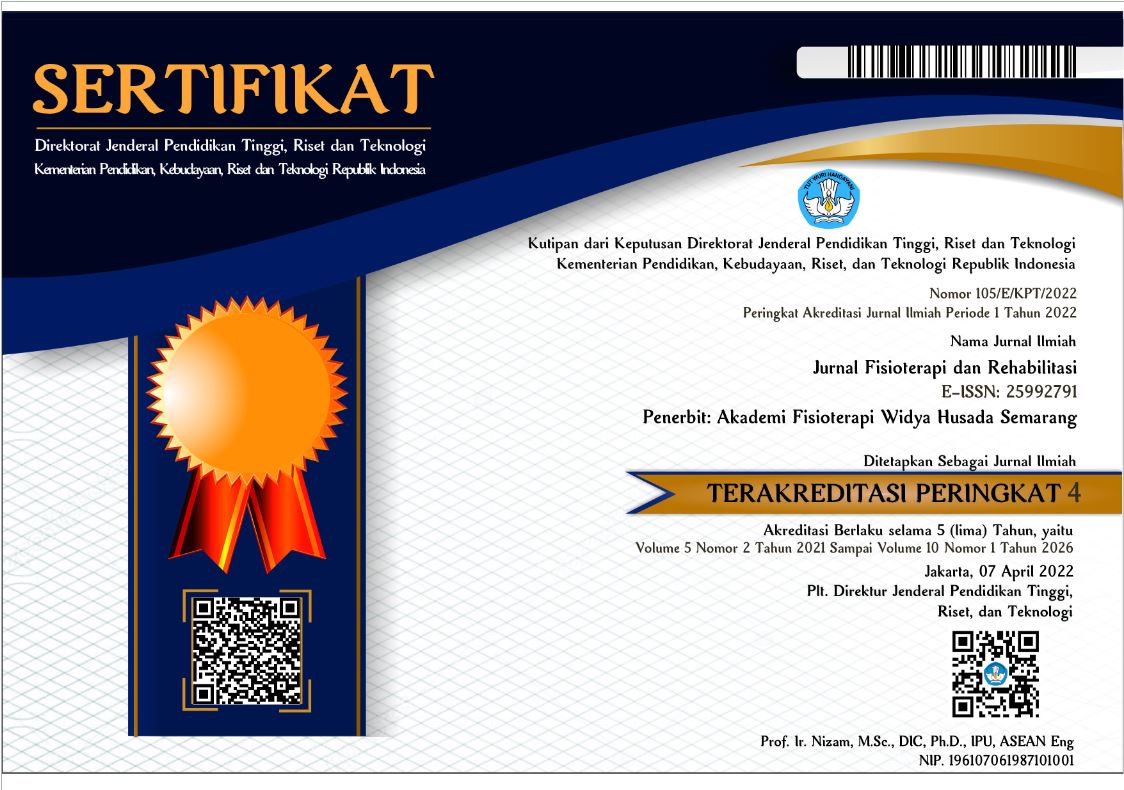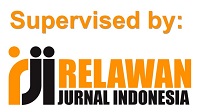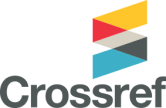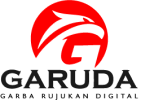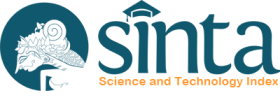KELEMAHAN OTOT GLUTEAL SEBAGAI FAKTOR RESIKO MUNCULNYA KELUHAN NYERI PUNGGUNG BAWAH
Abstract
Otot sebagai jaringan lunak kontraktilitas yang ada pada tubuh manusia tersusun oleh rangkaian yang saling berhubungan. Rangkaian ini menunjukkan bahwa kerja otot saling mempengaruhi dalam menjalankan fungsinya. Fungsi dari otot sebagai stabilisator maupun mobilitator dibedakan atas lapisan dan letak otot tersebut. Mobilitas yang ada di ektremitas baik atas maupun bawah tentunya akan lebih baik jika ditunjang stabilitas pada batang tubuh. Kondisi batang tubuh yang kurang baik dapat dilihat dari postur yang buruk serta adanya keluhan nyeri pada punggung bawah atau yang sering disebut low back pain. Nyeri punggung bawah sebenarnya merupakan simtomatif yang merujuk adanya masalah pada area punggung ke bawah. Masalah ini dapat muncul karena ketegangan otot akibat aktivitas yang berlebih pada otot punggung dan dapat disebabkan oleh kerja otot lain yang kurang aktif. Salah satu aktivasi otot yang turut menetukan beban kerja pada otot punggung adalah kelompok otot gluteal. Otot-otot gluteal merupakan komponen penting pada saat trunk berada pada posisi setengah ekstensi dari posisi fleksi penuh. Secara anatomi, kelompok otot ini memberikan stabilisasi lateral pada sendi panggul dan panggul karena tugasnya adalah mengontrol posisi panggul dalam menjaga stabilitas batang tubuh. Pada individu yang memiliki kecenderungan duduk dalam waktu yang lama, otot gluteal dapat mengalami atropi dan penurunan kekuatan/aktivasi. Hal ini merubah kestabilan kerja pada otot panggul dan batang tubuh pada bagian depan dan belakang serta atas dan bawah. Konsep muscle imbalance dimana bagian yang menurun aktivasinya akan memicu aktivasi berlebih pada bagian lain dan dari hal inilah muncul keluhan muskuloskeletal pada pinggang bawah yang ditandai dengan adanya nyeri pada area pinggang bawah.
Downloads

This work is licensed under a Creative Commons Attribution 4.0 International License.
The use of the article will be governed by the Creative Commons Attribution license as currently displayed on Creative Commons Attribution 4.0 International License.
Author’s Warranties
The author warrants that the article is original, written by stated author(s), has not been published before, contains no unlawful statements, does not infringe the rights of others, is subject to copyright that is vested exclusively in the author and free of any third party rights, and that any necessary written permissions to quote from other sources have been obtained by the author(s).
User Rights
JFR's spirit is to disseminate articles published are as free as possible. Under the Creative Commons license, JFR permits users to copy, distribute, display, and perform the work. Users will also need to attribute authors and JFR on distributing works in the journal.
Rights of Authors
Authors retain all their rights to the published works, such as (but not limited to) the following rights;
- Copyright and other proprietary rights relating to the article, such as patent rights,
- The right to use the substance of the article in own future works, including lectures and books,
- The right to reproduce the article for own purposes,
- The right to self-archive the article
Co-Authorship
If the article was jointly prepared by other authors, any authors submitting the manuscript warrants that he/she has been authorized by all co-authors to be agreed on this copyright and license notice (agreement) on their behalf, and agrees to inform his/her co-authors of the terms of this policy. JFR will not be held liable for anything that may arise due to the author(s) internal dispute. JFR will only communicate with the corresponding author.
Miscellaneous
JFR will publish the article (or have it published) in the journal if the article’s editorial process is successfully completed. JFR's editors may modify the article to a style of punctuation, spelling, capitalization, referencing and usage that deems appropriate. The author acknowledges that the article may be published so that it will be publicly accessible and such access will be free of charge for the readers as mentioned in point 3.




